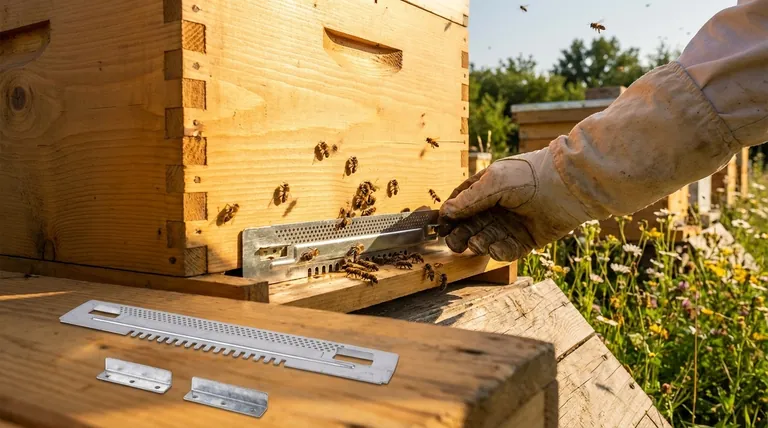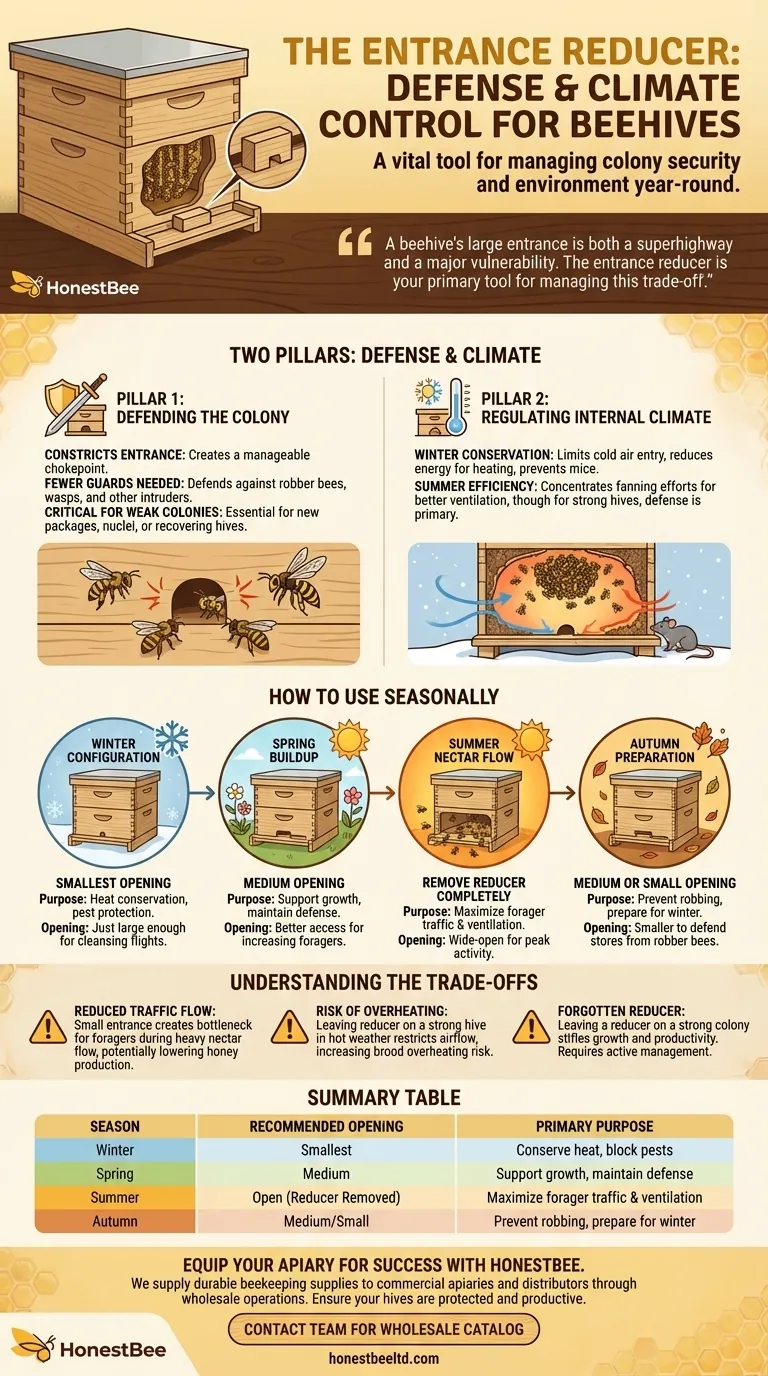At its core, an entrance reducer is a simple wooden block used to shrink the main opening of a beehive. Its purpose is twofold: to make the entrance easier for the bees to defend against intruders and to help the colony regulate the hive's internal temperature and airflow. This tool is fundamental for managing a colony's security and environment throughout the year.
A beehive's large entrance is both a superhighway for foragers and a major vulnerability. The entrance reducer is your primary tool for managing this trade-off, allowing you to adapt the hive's defensibility and ventilation to the colony's strength and the current season.

The Two Pillars of an Entrance Reducer: Defense and Climate
A reducer's function can be broken down into two essential benefits for the colony. Understanding these is key to knowing when and how to use it effectively.
Pillar 1: Defending the Colony
A full-width Langstroth hive entrance is a massive space for a small or developing colony to guard.
An entrance reducer constricts this opening, creating a smaller, more manageable chokepoint. This allows fewer guard bees to effectively defend the hive against robber bees from other colonies, wasps, and other intruders.
This defensive advantage is most critical when a colony is weak, such as a newly installed package, a small nucleus hive, or a hive recovering from disease.
Pillar 2: Regulating the Internal Climate
Bees work constantly to maintain a stable internal hive temperature, especially around the brood nest (approx. 95°F / 35°C). The main entrance is the biggest source of heat and air exchange.
In winter, a reduced entrance limits the amount of cold air entering the hive. This drastically reduces the energy the bee cluster must expend to generate heat, helping them conserve vital honey stores. A small opening also prevents mice from entering to seek warmth.
In summer, a reducer's role in climate control is less direct. While it restricts airflow, it also concentrates the bees' fanning efforts, making ventilation more efficient over a smaller area. However, for a strong hive in hot weather, its primary purpose shifts back toward defense.
How to Use an Entrance Reducer Seasonally
The size of the entrance opening should change as the seasons and the colony's population change. Most reducers have at least two different-sized notches.
Winter Configuration
Use the smallest possible opening. This prioritizes heat conservation and protection from rodents. The opening should be just large enough for a few bees to pass through for cleansing flights on warm days.
Spring Buildup
As the queen begins laying and the population grows, you can rotate the reducer to a medium-sized opening. This gives the growing number of foragers better access while still providing good defense for the still-modest colony.
Summer Nectar Flow
For a strong, populous hive, remove the reducer completely. This creates a wide-open entrance, preventing a "traffic jam" of foragers and maximizing ventilation during the hottest part of the year. An open entrance is a sign of a healthy, booming colony.
Autumn Preparation
As the nectar flow ends and temperatures cool, robbing behavior increases. Re-install the reducer to a medium or small opening. This helps the bees defend their winter stores from desperate robber bees and begins preparing the hive for winter.
Understanding the Trade-offs
Using an entrance reducer is not without its costs. A beekeeper must actively manage it to avoid hindering the colony.
The Cost of Security: Reduced Traffic Flow
The most significant trade-off is efficiency. A small entrance can create a bottleneck for foraging bees during a heavy nectar flow. This "traffic jam" can directly reduce the amount of nectar and pollen coming into the hive, potentially lowering honey production.
The Risk of Overheating: Restricted Ventilation
Leaving a reducer on a strong hive during hot weather can be detrimental. It severely restricts natural airflow, forcing the bees to work much harder to cool the hive and increasing the risk of the brood overheating. This is why removing it is standard practice for strong hives in summer.
The "Forgotten Reducer" Problem
A common mistake for new beekeepers is to install a reducer and forget about it. Leaving a reducer on a colony that has become strong will stifle its growth and productivity. It's a tool that requires active management, not a "set it and forget it" component.
Making the Right Choice for Your Hive
The decision to use a reducer, and which opening to use, depends entirely on your specific goal for that colony at that moment.
- If your primary focus is protecting a new or weak colony: Use the smallest opening to prioritize defense above all else.
- If your primary focus is maximizing honey production in a strong hive: Remove the reducer entirely during the nectar flow to ensure maximum forager traffic.
- If your primary focus is winter survival: Use the smallest opening to conserve heat and prevent pests from entering the hive.
- If your primary focus is preventing robbing during a nectar dearth: Reduce the entrance to a size the colony can easily defend.
Properly managing the entrance reducer is a simple yet powerful way to help your bees thrive by adapting their home to the changing world outside.
Summary Table:
| Season | Recommended Opening | Primary Purpose |
|---|---|---|
| Winter | Smallest | Conserve heat, block pests |
| Spring | Medium | Support growth, maintain defense |
| Summer | Open (Reducer Removed) | Maximize forager traffic & ventilation |
| Autumn | Medium/Small | Prevent robbing, prepare for winter |
Ready to equip your apiary with the right tools for success? Proper hive management starts with quality equipment. HONESTBEE supplies durable beekeeping supplies and equipment to commercial apiaries and distributors through wholesale-focused operations. Ensure your hives are protected and productive year-round—contact our team today to discuss your needs and explore our wholesale catalog!
Visual Guide

Related Products
- Beehive Entrance Reducer Guardian Metal Hive Entrance for Bees
- Multi-Functional Sliding Hive Entrance for Beekeeping
- Multi-Functional Rotary Hive Entrance Disc for Beekeeping
- Professional Reversible Beehive Hive Entrance
- Professional Galvanized Hive Strap with Secure Locking Buckle for Beekeeping
People Also Ask
- How big should a beehive entrance be? Optimize for Colony Health & Honey Production
- How can a Langstroth hive entrance be adjusted? Mimic Natural Bee Preferences for a Healthier Hive
- What is the purpose of placing an object in front of the hive entrance after a move? A Guide to Forced Reorientation
- What are the two functions of the Entrance Reducer? Master Hive Defense and Safe Transport
- What happens if you seal an entrance to a bee hive? Avoid a Costly Structural Disaster



















